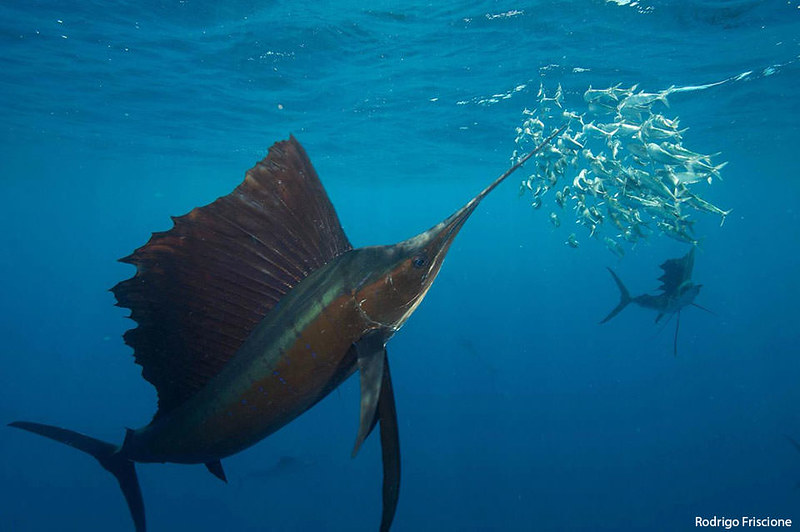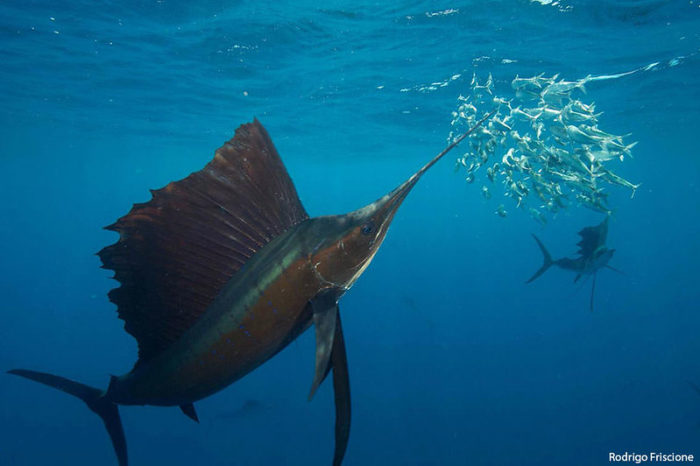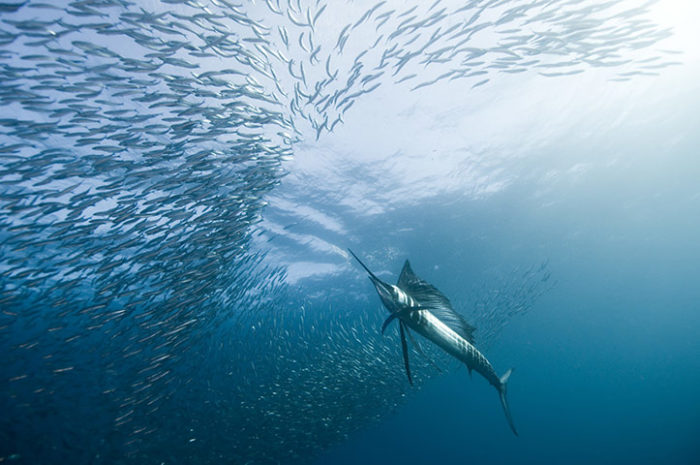
Sea Wonder: Sailfish

Photo credit: Rodrigo Friscione/NOAA
Batten down the hatches and get ready to set sail as we learn about sailfish! These billfish are similar to blue and white marlin, and are known and named for their tall dorsal fins, pointed bills, and incredible speed. In fact, they are the fastest known fish in the global ocean. You could say they live life in the fast lane. Their athleticism and proximity to coasts are part of what makes sailfish so popular among game fishers.
Description
Sailfish (Istiophorus sp.) are two species of billfish that are closely related to blue and white marlin. These marine fish are named for their sail-like dorsal fin, which spans nearly the entire length of their bodies and can grow on some individuals to be taller than these fish are long! The dorsal fin can be lowered and extended much like the sail of a ship. Depending on where they are in the ocean, sailfish can grow to be between six and 11 feet long, and weigh between 120 and 230 pounds.
They are blue-gray in color with silvery hues, blue dots along their sides, and white underbellies. Their bodies are torpedo-shaped and slightly flattened on the sides, and they are known for the elongated and pointed bill that extends the front of their bodies – just don’t mistake them for swordfish. Thanks to their hydrodynamic bodies and incredibly powerful musculature, sailfish are considered some of the fastest swimmers in the global ocean, able to reach speeds of nearly 70 miles per hour or about 60 knots.
Diet and Habitat
A sailfish’s diet changes throughout its lifetime. They start out feeding on zooplankton and the size of their prey changes as they grow. Adults are known to eat medium and large bony fishes, crustaceans, and squid. Sailfish may use their elongated bills to disorient or stun prey, and they definitely use speed to their advantage. When feeding as a group, sailfish can work together by using their dorsal fins that creates a barrier around their prey. They most often use this strategy on smaller fish that travel in large schools, such as sardines and anchovies. Adult sailfish have few natural predators that include orcas, open ocean sharks, and mahi mahi, though young individuals are preyed upon by other fishes that feed on plankton and small fish.
Sailfish live a few miles off shore in the open ocean, spending most of their lives close to the surface and are commonly found near coral reefs. When they need to, they can dive as far down as 1,500 feet, which they most often do to chase down prey. Sailfish live throughout the global ocean, most commonly in the Atlantic and Pacific oceans. In the National Marine Sanctuary System, sailfish are most commonly seen in and near Gray’s Reef, Florida Keys, and Channel Islands national marine sanctuaries.
Life History
Sailfish reproduce through external fertilization or spawning, which involves adult males and females releasing gametes (eggs and sperm cells) into the water column. To attract males, an adult female will extend her dorsal fin above the surface of the water. A short series of mating behaviors takes place when adults meet, and females release several million clear eggs at a time to increase the likelihood of fertilization. The fertilized eggs that aren’t eaten or destroyed usually hatch within 36 to 48 hours, and the hatchlings that survive their first week of life grow quite quickly. In their first year of life alone, sailfish can grow 4 to 5 feet in length, a miraculous feat given their nearly microscopic size at hatching.
Sailfish fish reach adulthood when they reach their maximum individual size, which usually occurs at around the age of three. These fish have a maximum lifespan of 13 to 15 years, though their average lifespan is reduced to between 4 and 5 years if they are repeatedly caught and released by sports fishermen. Adults can live in groups and independently, and they travel to different areas of the ocean throughout the year, often alongside their prey that migrate seasonally.
Threats and Conservation
While sailfish have natural predators throughout their life cycles, adult sailfish are also targeted by people. Their meat is tough and not widely eaten, so they have little economic value to commercial fisheries. They are sometimes caught unintentionally as bycatch with gear like driftnets, harpoons, and long-line fishing gear, all of which pose threats to sailfish populations. Sailfish are popular among sports fishermen, however, given their athleticism and the skill it takes to land one. In areas of the ocean where fishing for sailfish is allowed, regulations usually require that they be released immediately.
Fortunately, sailfish are thought to be abundant throughout their range and their populations are considered stable, in part due to regulatory protections they receive. Like many other marine species, threats like climate change, ocean acidification, and coastal development may lead to population declines in the future.

Photo credit: jidanchaomian
